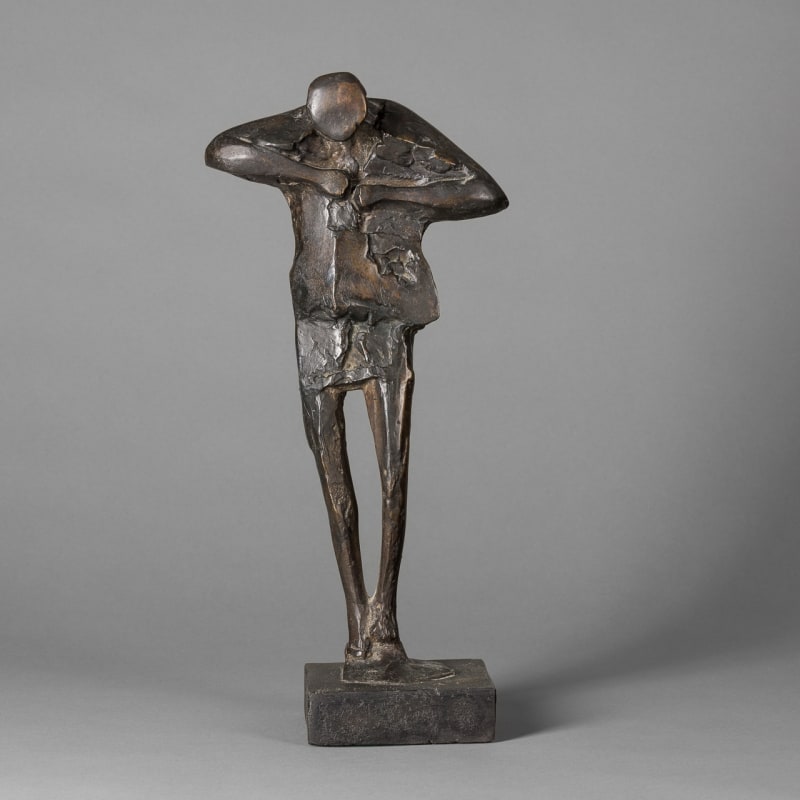Austin Wright (1911-1997) was born in Chester in 1911 and grew up in Wales, although he spent the majority of his life living in North Yorkshire in a village just outside of York. He initially started his career as a teacher in 1934, instructing Modern Languages at The Downs School in Herefordshire where he lived with his colleague and friend the poet W H Auden. In The Sculpture of Austin Wright, James Hamilton notes that 'Wright unavoidably became a wry observer of Auden's love affairs, and also his confidante', showing how progressive Wright was during a time when homosexuality was still criminalised. During this period Wright was also developing his own artistic practice, with his earliest surviving wood carving dated from 1939 and is a carving of an abstracted figure made from pinewood.
Wright's sculpture became more widely recognised in the 1950s when he was commissioned by institutions such as Manchester City Council, Wakefield Cathedral and Derby Cathedral to create large-scale pieces. The focus of his work was mainly figurative during this decade, focussing on individuals or small groups of people and abstracting the limbs and heads. In 1955 the art historian and critic Charles Sewter wrote in the Manchester Guardian that 'it would not be outrageous to claim that Wright is the most gifted sculptor working in Britain today'. The following year he was asked to participate in the touring British Council show Young British Sculptors alongside Robert Adams, Kenneth Armitage, Reg Butler, Lynn Chadwick, Robert Clatworthy, Hubert Dalwood, Elizabeth Frink, Bernard Meadows, Eduardo Paolozzi, Leslie Thornton and William Turnbull. He was fascinated not just by the figures but also by the negative space between them and the energy that seemed to hang within the void.
Wright was chosen by a prestigious selection committee to participate in the 1957 Säo Paulo Biennale in Brazil. The committee included some of the most influential curators, critics and writers of the period such as Roland Penrose, Sir Herbert Read, Sir John Rothenstein, and Lilian Somerville. The exhibition was titled Ten Young British Sculptors and featured many of the artists who had appeared in the earlier Young British Sculptors exhibition, with the additions of F. E. McWilliam, Leslie Thornton and Ben Nicholson. It was here that he was presented with the Richardo Xavier da Silveria Acquisition Prize for his sculpture The Argument.
In 1961 Wright was awarded the Gregory Fellowship for a term of three years at the University of Leeds, which caused a shift in his focus from the figurative sculptures he had been producing up to the 1950s to botanical forms. This shift was largely due to his friendship with Professor Irene Manton who he met at the Botany department at the University. Manton not only had a wealth of knowledge about the interior structure of plants, which influenced Wright's work greatly, but she was also a collector of art and antiquities. After her death, Manton donated her collection to the University of Leeds, which included examples from early Egypt, Greece and Cyprus but also of modern art from artists such as Pablo Picasso, Henry Moore and Joan Miró. Wright would have no doubt been influenced by the art and antiquities Manton collected as these were displayed throughout Botany House, where she worked while at the university.
This exhibition explores the two distinct themes of Wright's work found in his figurative and botanical forms, through examples of his sculptures and works on paper. A representation of the artists studio has been constructed within Gallery One as part of the exhibition and will include original maquettes, moulds and archival material, giving visitors an insight into how the interior of this workshop may have looked.
The barn behind his home in Upper Poppleton is where Austin Wright created the vast majority of his sculptures, though it was never referred to as his 'studio' during his lifetime this building not only provided the space he needed but also became an inspiration in itself. Old farming equipment hung from the walls and rafters which influenced his unique hanging sculptures. These pieces are made from aluminium and are lightweight enabling them to move in the wind, they were often hung outside from trees in his garden where this motion could be viewed more effectively.
The garden that surrounded Wright's home appears regularly within his work from the sculptural Iris seedheads to the sprawling cherry tree. Though this connection to nature is more apparent in his later botanical studies, his figurative drawings and sculptures are also deeply rooted in the environment, exploring how the curves of the body can mimic rock formations and blend into the landscape.
A vast range of materials can be seen within this recreation, from the incredibly delicate wire and plaster maquettes to the robust and tactile lead and concrete sculptures. Two wax figures can also be found within their original boxes, perfectly preserved. Amongst the tools and old furniture, there is a collection of moulds, some with the name of the final piece written on the outside and bound together with string or rubber to keep the two sides in place.
Another exciting addition is the documentary The Secret Middle (courtesy of the Yorkshire Film Archive), which was produced and directed by award-winning British screenwriter Harry Duffin in 1967. This film follows Wright around his home in Upper Poppleton as he explains his process. The full documentary is played throughout the exhibition.


